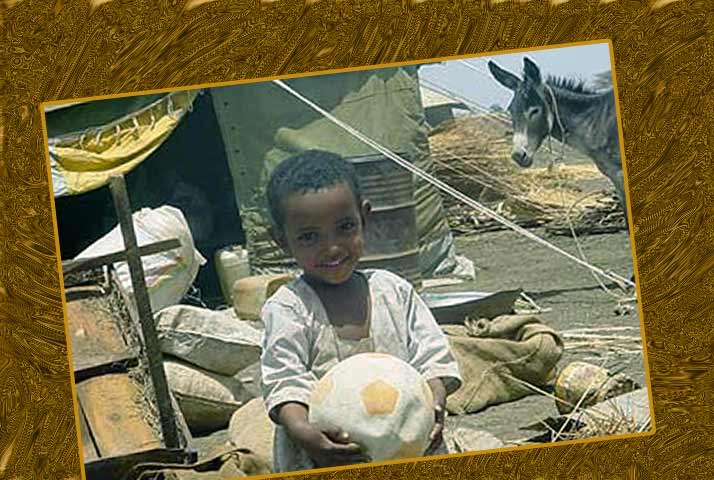Eritrean Refugees: Fifty Years of Injustice

[Editor’s note: This content was first published on Feb 15, 2017.]
The Eritrean refugee’s story is a difficult one to tell. Eritrean refugees in the Sudan made history twenty years ago, by becoming the longest stayed displaced refugees in the world. The length of time, the relatively friendly atmosphere accorded to most refugees by the Sudanese government and people, and the similarity between the Sudanese and most of the earlier Eritrean refugees, artificially camouflages the signs of their plight, effectively.
Although Sudan was already well accustomed to thousands of social refugees from Ethiopia and Eritrea for a long time, the first officially recognized Eritrean political refugees arrived there in 1967.
At least, until 1991 when Eritrean independence was but assured, most of the refugees in the Sudan had the never dimming gleam of hope about someday returning home and living the rest of their lives with dignity. For a fraction of them that dream came true. For the great majority however, that hope started to turn into a nightmare starting in 1993.
This article is by no means a detailed account of Eritrean refugees in the Sudan but, if anything at all, it should only be viewed as a mere supplement to Saleh G. Johar’s article “Eritrean Refugees In Sudan: 50 Years And Counting.”
As of 1991, it was widely believed that there were approximately 750,000 Eritrean refugees all over the world. The UNHCR, The Sudan, and Eritrea all agree that around 500,000 of those were in the Sudan.
Since 1991, thousands of Eritreans, euphoric with the much anticipated and just acquired independence started to head back home.
By 1993, rumors of voluntary repatriation had begun to spread, and Mr. Elkhatim, a Sudanese representative at the UNHCR’s refugee program general debate of 1993, warned the attendants how seriously exaggerated the rumor was and to not be swayed by it nor stop financing the refugee camps.
In the meantime several misunderstandings between Sudanese and Eritrean governments regarding methods, organization, and timing of the repatriation program were festering and in 1994 they began to exchange war of words in the open.
The UNHCR, although caught in the middle, had several projects related to the refugees underway, both in the Sudan and Eritrea, both of whom kept reporting, and thus asking it to consider their respective reports more in its budgeting scheme. While the Sudanese government insisted that only a small fraction of refugees have returned and the great majority were still in the Sudan, the Eritrean government equally insisted that it was overwhelmed by the sheer number of returnees.
Failing to secure a tripartite agreement between itself, UNHCR, and Eritrea, when the latter refused to sign the agreement, Sudan and UNHCR signed an agreement on the methods and timing of the repatriation program they both devised.
Although over a hundred thousand were planned to be repatriated in early-mid 1990s, only 25,000 were repatriated under a pilot program conducted between November 1994 and May 1995.
Citing the “various political and technical problems”, and differences between the Governments of Eritrea and Sudan, UNHCR stated that the organized repatriation was stalled.
Along with the joint effort by the Sudan and UNHCR to repatriate a portion of refugees as a pilot program, there were thousands of enthusiastic Eritreans already repatriating themselves mostly in the Gash-Setit sub-region such as those who established the now vibrant town of Alebu.
The successes of some of these voluntary returnees are important to, at least partially gauge, the Eritrean government’s state of mind at the time. In fact, one has to assume that perhaps, these types of successes may have encouraged it to insist on voluntary repatriation instead of what Sudan and UNHCR were proposing at the time.
In the advent of the Eritrea-Sudan diplomatic breakdown, Sudan reported distress by the number of potential returnees who were demanding a security guarantee from it and the UNHCR before they were shipped back to Eritrea, perhaps by those uncertain about their fate once they returned; according to the Sudanese government, they were the great majority of the refugees at the time.
Sudan proposed a well-organized and timely repatriation program. It got UNHCR’s cooperation but not Eritrea’s, which demanded a voluntary repatriation only, citing several reasons including the need for new infrastructures, health, and other safety issues. It received UNHCR’s cooperation in most cases but not Sudan’s who by then was accusing Eritrea of playing delaying tactics.
Toward the end of 1995, Eritrea was entangled in a clash with Yemen over ownership of a few islands and marine border line.
The repatriation war of words intensified farther and Eritrea accused Sudan of abusing the refugees while it accused Eritrea of “squandering its meager resource on war adventure” instead of taking care of the long-awaited repatriation program.
Between early 1996 to the end of 1997, the number of volunteer returnees began to dwindle while at the same time the number of repeat refugees (repatriated and later then becoming refugees again) began with an increased pace. 1996 and 1997 virtually passed with Sudan complaining about the damage it was sustaining from refugee influx while Eritrea kept tightening the screening process with “security reasons” now added to its earlier capacity related reasons.
However, even with those tight scrutiny and delays, the Eritrean government claimed that between 1991 and 1998 it had repatriated nearly 200,000 returnees.
In addition, in 1998 the Sudan, UNHCR, and Eritrea had finally agreed to resume the repatriation program, starting in May of 2000, it was again shelved due to the Ethio-Eritrean border war of 1998-2000.
Though the demands of repatriation cannot be underestimated, Eritreans seem to be divided on the question of whether the government used the “voluntary repatriation” scheme to filter out those it perceived as its “enemies”, or whether it was indeed too overwhelmed as it claimed and it had done everything it could with the resources it had.
True or not, the fact that EPLF’s inception had some “religious” connotation to it, and it militarily removed the ELF from Eritrea, and of course, the PFDJ’s subsequent behaviors, such as refusing to allow the remains of its old rivals who die in exile to return to Eritrea, suggests a possibility that it is purposely blocking or delaying the refugee repatriation program. In addition, at the time it was an organization that just come out after decades long war, with a new nation already devastated by wars, with almost insignificant infrastructure, and overwhelmed by tens of thousands of refugees, among other crisis. It is equally plausible that regardless of how much it may have wanted to repatriate all the refugees, it may have been unable to do so.
References and further reading:
- General debate at the forty fourth session of the Executive Committee, The United Nations High Commissioner for Refugees
- UNHCR Global Appeal 1999 – Eritrea
- UN General Assembly, Summary Record of the 511th Meeting
- The State of The World’s Refugees 1997: A Humanitarian Agenda
- Getting Home is Only Half the Challenge: Refugee Reintegration in War-Ravaged Eritrea




Awate Forum